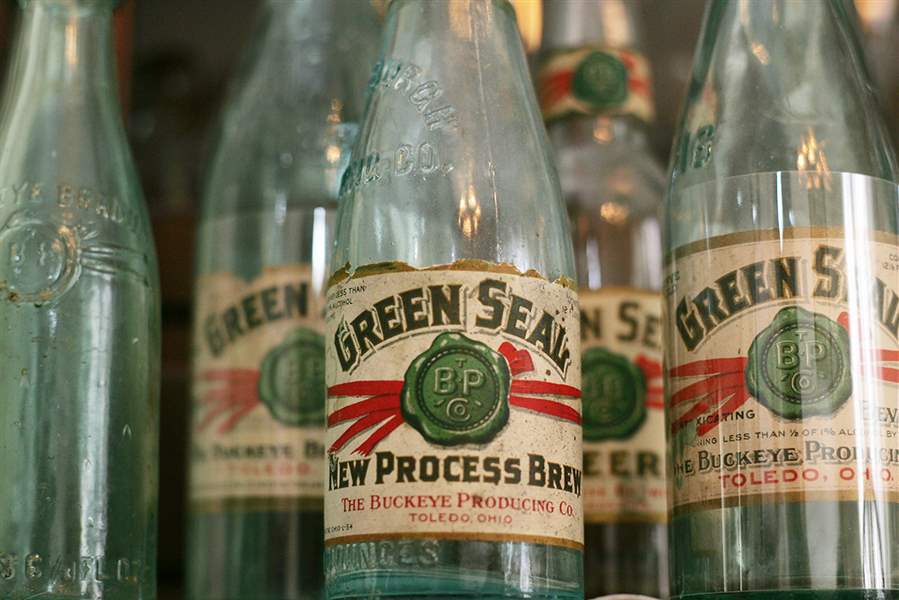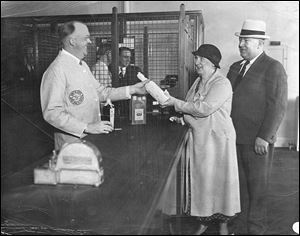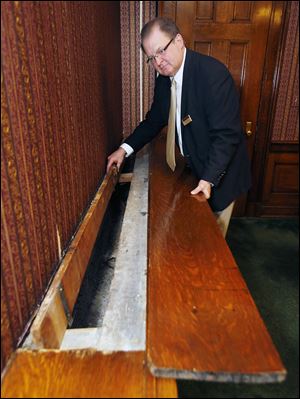
80 YEARS AGO: 21ST AMENDMENT
Ohio among last 3 states to usher Prohibition’s end
12/6/2013
These Prohibition Era-bottles were produced by Buckeye Brewery Co., based in Toledo and established in 1836.
THE BLADE/AMY E. VOIGT
Buy This Image

These Prohibition Era-bottles were produced by Buckeye Brewery Co., based in Toledo and established in 1836.

Mr. and Mrs. George Lumley attend a liquor store opening on Huron Street. Liquor stores had to be state-owned until the 1990s.
First came the votes. Then came the wait. And finally, the booze.
Eighty years ago Thursday, then-Ohio Gov. George White called a special legislative session to repeal state laws prohibiting alcohol sales, sparked by historic votes the day before. Ohio was among a trio of states on Dec. 5, 1933, that were the last to ratify the 21st Amendment, repealing the 18th Amendment and ending Prohibition.
Headlines in The Blade read as if the ratification process were a prize fight, with repeal winning with a vicious TKO.
“U.S. Prohibition To End Tonight,” one headline read. “9:30 p.m. Is Set For Death Blow.”
RELATED LINK: Prohibition-era document from the Toledo Club.
Wire-service reports of Prohibition’s end seemed nearly jubilant, calling it the end of a “14-year-old drama of the experiment that failed.”
Ratification of the 21st Amendment was the only time Congress had states use conventions — instead of state legislatures — to decide if three-fourths of the states approved. Ohioans voted Nov. 7 for convention delegates, who included Zora S. Cummings of Toledo, Louis M. Hirshson of Maumee, and Carl F. Orth of Wauseon.
Stories nearly lamented that Ohio would not be the 36th state to ratify. The convention in Utah had been moved back several hours, giving it the historic footnote as the state that officially legalized alcohol sales in the United States. Ohio actually was officially the 34th state, as Pennsylvania’s vote came in later that day as well.
The repeal didn’t mean corks could pop and kegs could flow right away. About two weeks of debate began in Columbus over how alcohol would be regulated, distributed, and taxed. Ohio lawmakers finally settled on a monopoly system that limited liquor wholesale and retail sale to state stores. In Toledo, the first of those were at 440 N. Huron St. and 229 N. Superior St.
The compromise legislation included oddities of the time while trying to regulate a product once considered too evil to sell to the masses. Legislation would bar the sale of alcohol to “habitual heavy drinkers” and to anyone on election days. It specifically allowed women to serve hard liquor.
Governor White finally signed the legislation at 10:59 a.m. Dec. 23, 1933, but booze didn’t flow freely immediately after that, either.
State stores would need time to open, and there would be a delay before establishments could sell liquor or beer by the glass. Drug stores were given temporary permits to sell packaged liquor off site. The permits were popular.
“Scarcely had the doors opened than druggists started filing in,” to the permit office, The Blade reported. “Within two hours more than a hundred had paid the fee.”
Floyd Waite, a Toledo “wholesale druggist” of Walding, Kinnan, and Marvin, was the first to get a hard-liquor permit in the state.
Finally, on Jan. 20, 1934, the former Secor Hotel, on Jefferson Avenue at Superior Street, became the first establishment in Toledo to be granted a license to serve drinks by the glass. Or, as The Blade said at the time, it was the only official public oasis for “those seeking a legal lift of the juice that joys.”
Newspapers ran lists of available liquor in the city, complete with price ranges.
Other prominent establishments soon would receive licenses, though they were perplexed why theirs were delayed. The Commodore Perry Hotel expected to pour drinks soon, its manager said, and the Toledo Club would offer stiff drinks — legal ones — by the following week.
In what is now the Uptown club’s business center was “St. Andrew’s Room” during Prohibition, club general manager Roger Parker said.
The room had a wall-panel hideaway where contraband liquor could be hidden if a raid were expected. The hideaway is still there.
The state defined an intoxicating beverage as anything with more than 3.2 percent alcohol by volume, and brewers raced to make and distribute stronger beer. The Buckeye Brewing Co., established in 1836, immediately began stamping over 3.2 labels, according to The Blade.

Roger Parker, general manager of the Toledo Club, shows the hideaway used to stash liquor during Prohibition. At the time, the club’s business center was known as St. Andrew’s Room.
Neal Kovacik, the Oliver House’s general manager, said at one point, brewing “employed more people than any other business in Toledo.”
The city had multiple brewing operations, he said, because of European immigrants who came the city and established businesses. Buckeye Brewery began “bottling soft drinks during Prohibition.”
Establishments were eager to get liquor licenses, as bootlegging and underground drinking had made alcohol popular during Prohibition. But brewers and booze boosters weren’t the only ones who saw business boon from repeal. Blade stories said orders for Libbey Glass stemware ballooned, with production at capacity yet unable to meet demand. The company was 10 weeks behind on orders when liquor became legal in Ohio.
Ohio stuck with state liquor stores until the late 1990s, when liquor sales were privatized.
Some remnants of those old laws remain. There’s still the concept of local control, and municipalities and localities can choose to go dry if they wish.
In 2001, Ward 4, Precinct D in the Polish Village voted to ban alcohol sales and became Toledo’s first and only dry precinct. It wasn’t so much a principled statement as a recourse against a neighborhood bar that had become a nuisance, said Beth Lewandowski, vice president of the Lagrange Village Council, the neighborhood group that led the charge for the ban.
The precinct, bounded by Manhattan Boulevard and Lagrange, Weber, Elm, Hudson, and Maple streets, is still dry, and there’s been no real challenge to the designation. “I think it [Prohibition] would have a hard time getting passed nowadays,” Ms. Lewandowski said.
Some drinking establishments hold “Repeal Day” events to commemorate the anniversary, but it’s not exactly a holiday. Mr. Kovacik wasn’t aware Thursday was the 21st Amendment’s 80th anniversary, and had heard no chatter about it.
Blade writer Tom Henry contributed to this report.
Contact Nolan Rosenkrans at: nrosenkrans@theblade.com or 419-724-6086, or on Twitter @NolanRosenkrans.